I. Introduction
In the world of colors, blue is often considered a unique and rare hue that holds special significance in various aspects of human culture and the natural world. From the mesmerizing shades of the sky and ocean to the elusive blue gemstones and flowers, blue color has a distinct aura that captivates our senses and leaves us in awe. In this section, we will delve into the rarity of the blue color, exploring its definition, significance in the natural world, perception, and symbolism in human culture.
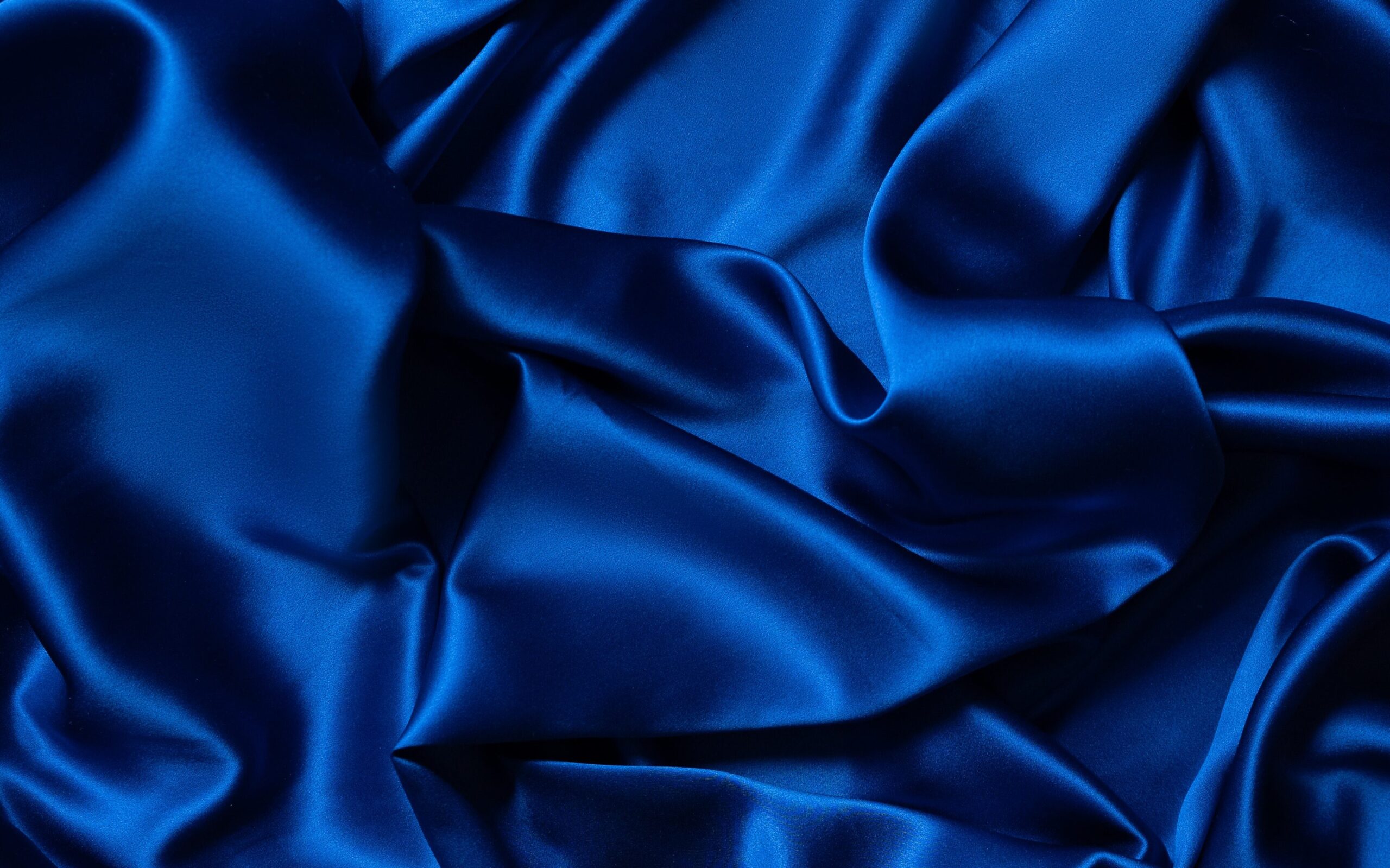
Unlike other colors, which are often abundant in nature, blue color is relatively rare. This is because the blue pigment molecules in the natural world are not as prevalent as other pigments. For example, chlorophyll, which gives plants their green color, is abundant in leaves, while carotenoids, which produce yellow, orange, and red hues in many fruits and flowers, are also widespread. However, blue pigments are less common, making the blue color a unique and exceptional phenomenon in nature.
II. Scientific Explanation of Blue Rarity
A. Explanation of light absorption and reflection in objects
The color of objects we see in the natural world is determined by the way they absorb and reflect light. When light from the sun or another light source strikes an object, the object’s surface interacts with the light. The surface may absorb certain wavelengths of light while reflecting others, and this determines the object’s perceived color.
In the case of blue color, objects appear blue because they selectively absorb longer wavelengths of light (such as red and green) while reflecting shorter wavelengths (blue) back to our eyes. This selective absorption and reflection of light is determined by the molecular and structural composition of the object.
B. 🔬 Role of Molecules and Structures in Determining the Color of Natural Objects
The unique coloration of objects in nature, including blue color, is a result of the specific molecules and structures present in the object’s composition. For example, in animals, plants, and minerals, various pigments and structures can create blue coloration.
In animals, blue coloration is often caused by microscopic structures in their skin, scales, or feathers that scatter light in a way that reflects blue wavelengths. This phenomenon, known as structural coloration, is responsible for the vibrant blue colors seen in butterflies, birds, and certain fish species.
In plants, blue coloration can be due to the presence of pigments called anthocyanins, which are responsible for the red, purple, and blue colors in many flowers, fruits, and leaves. These pigments selectively absorb and reflect light in the blue range of the spectrum, resulting in the blue coloration.
In minerals, blue coloration can arise from the presence of specific elements or compounds in their composition. For example, the blue color in gemstones like sapphires and aquamarines is caused by the presence of trace amounts of iron, titanium, or other elements in their crystal lattice structure.
C. 🌍 Rarity of Blue Pigments and Dyes in Nature Compared to Other Colors
Despite the beauty and allure of the color blue, blue pigments and dyes are relatively rare in nature compared to other colors. This rarity is due to several factors, including the scarcity of blue-absorbing and blue-reflecting molecules in the natural world, and the challenges associated with producing stable blue pigments and dyes.
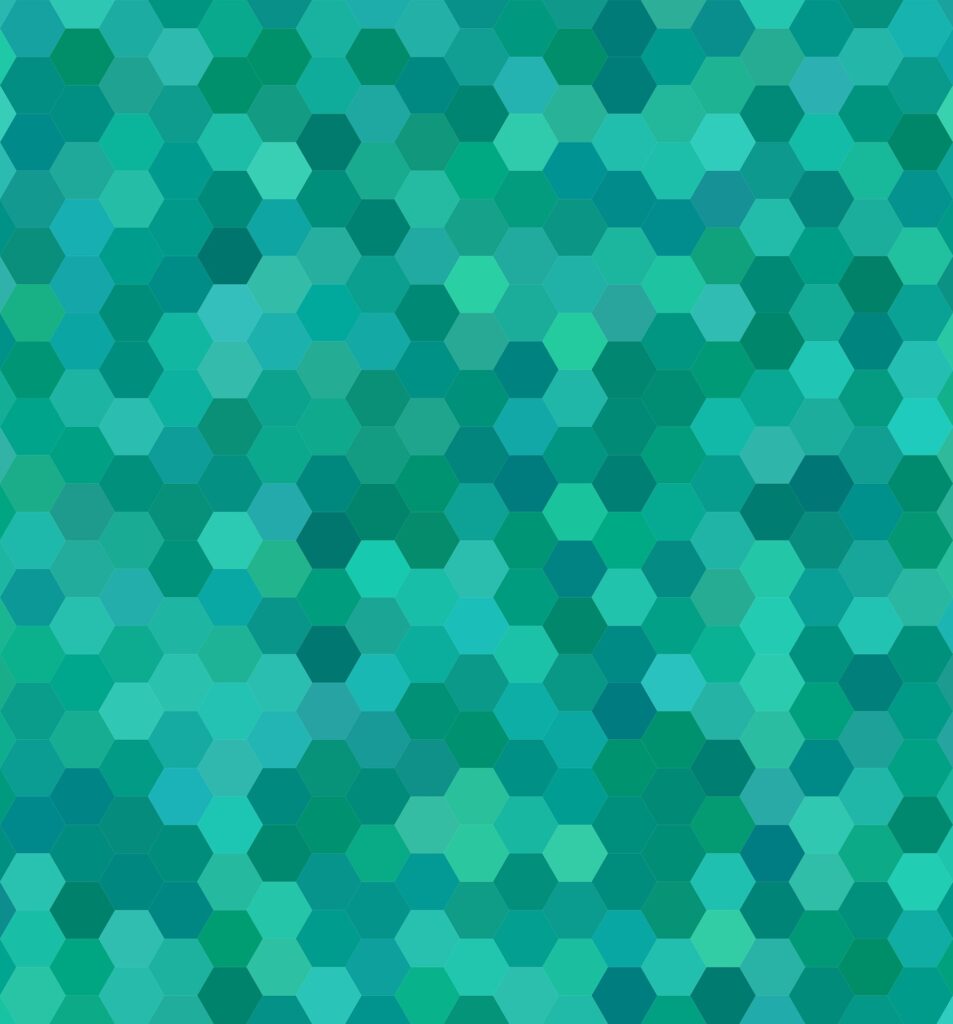
One reason for the rarity of blue pigments and dyes is that there are fewer naturally occurring molecules that selectively absorb or reflect blue wavelengths of light compared to other colors. This scarcity of blue-absorbing and blue-reflecting molecules in nature limits the availability of blue pigments and dyes.
Furthermore, producing stable blue pigments and dyes can be challenging due to their chemical properties. Blue pigments and dyes often require complex chemical structures and precise conditions for their synthesis, which can be difficult to achieve in nature. This adds to the rarity of blue coloration in natural objects.
D. 💠 Examples of Animals, Plants, and Minerals Exhibiting Blue Coloration and Their Unique Characteristics
Despite its rarity, blue coloration can be found in various animals, plants, and minerals in nature. Here are some examples:
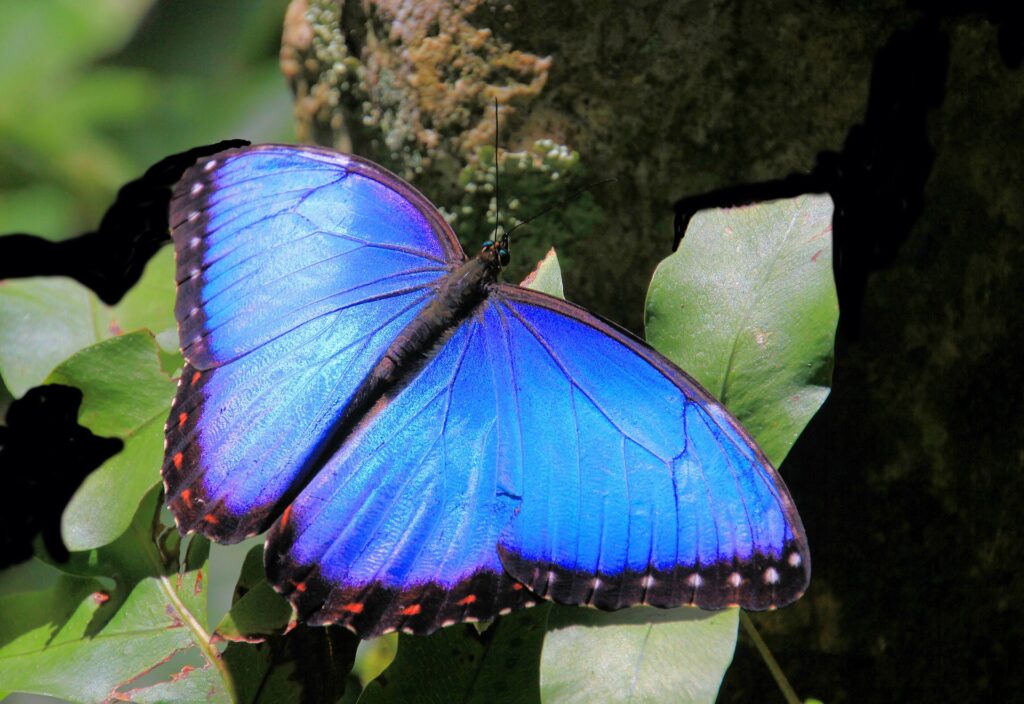
Blue Morpho Butterfly: This dazzling butterfly species found in Central and South America exhibits brilliant blue coloration on its wings due to microscopic scales that scatter light to reflect blue wavelengths.
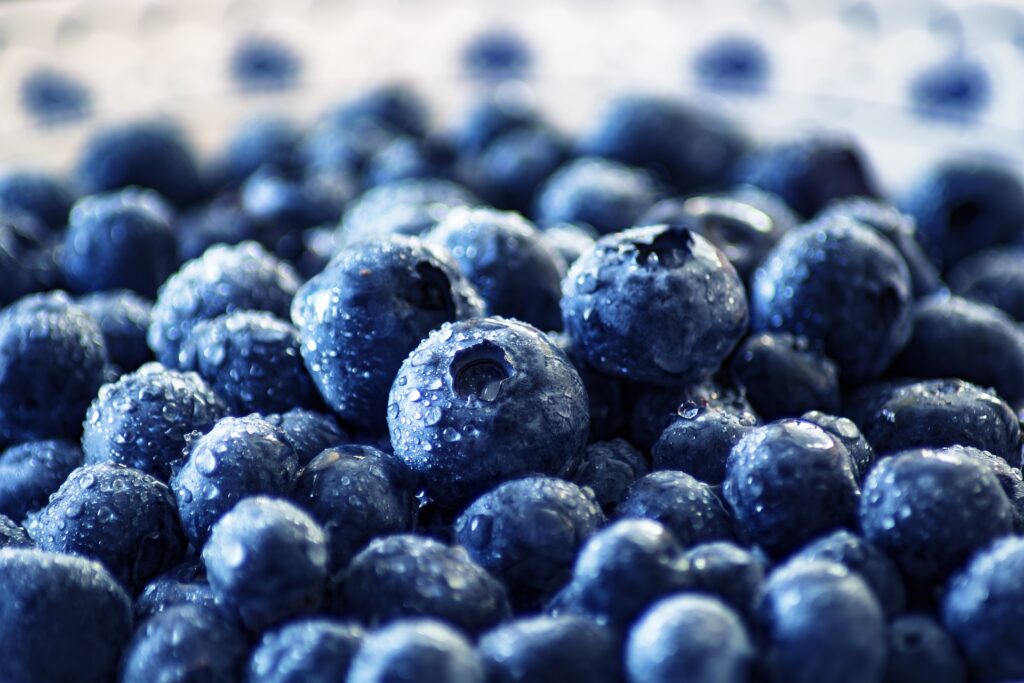
Blueberries: These delicious fruits contain anthocyanin pigments in their skin, which give them a blue coloration and are also known for their antioxidant properties.
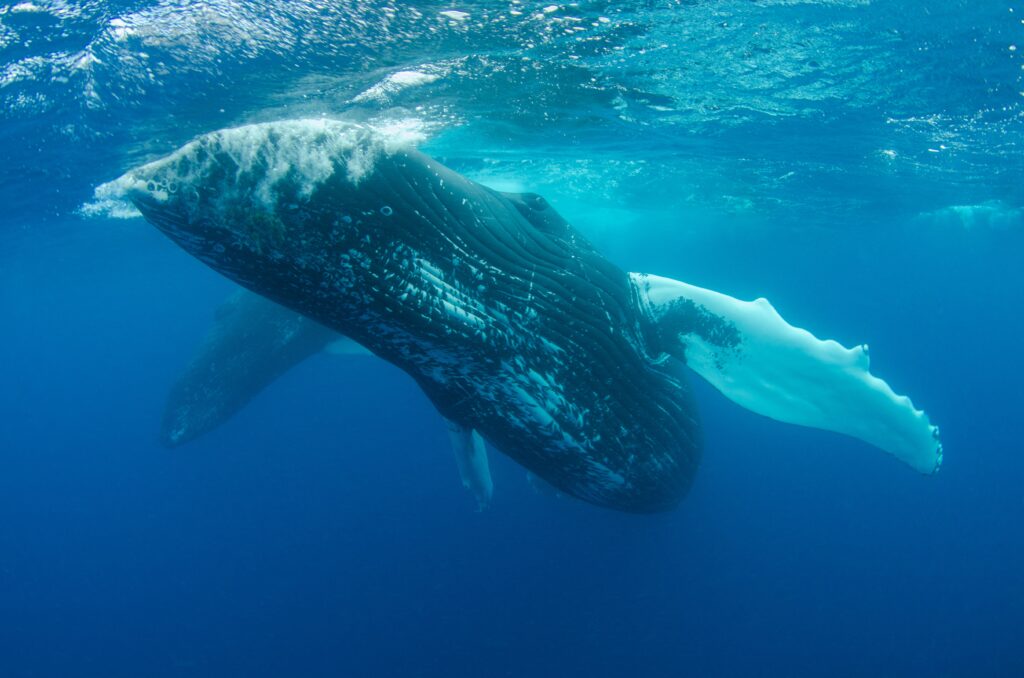
Blue Whale: The world’s largest mammal, the blue whale, appears blue underwater due to the way its skin absorbs and reflects light in the blue spectrum.

Lapis Lazuli: This gemstone, prized for its deep blue color, contains the mineral lazurite, which is responsible for its blue coloration. Lapis Lazuli has been used for centuries in jewelry and art due to its unique blue hue.
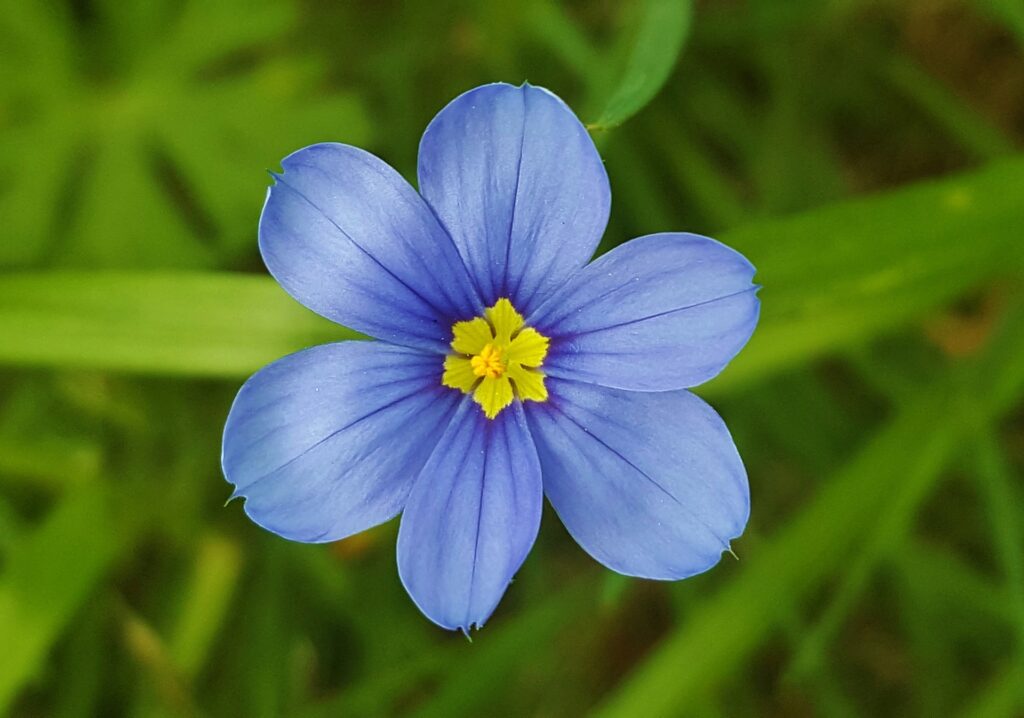
Blue-eyed Grass: This plant species, native to North America, has stunning blue flowers with yellow centers, adding a touch of blue coloration to meadows and grasslands.
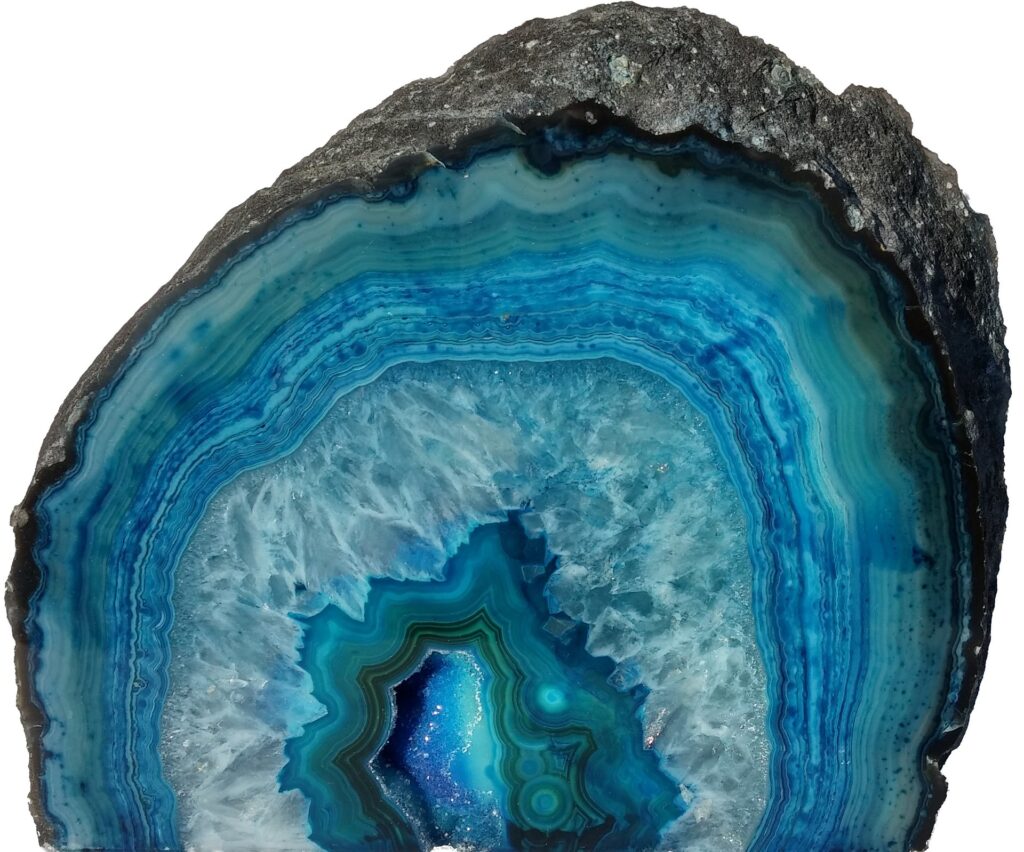
Blue Agate: This mineral, commonly used in jewelry and decorative objects, displays various shades of blue due to the presence of impurities such as copper, manganese, and iron in its composition.

Blue Poison Dart Frog: This small frog species, found in Central and South America, features a bright blue coloration on its skin, which serves as a warning to predators that it is toxic.
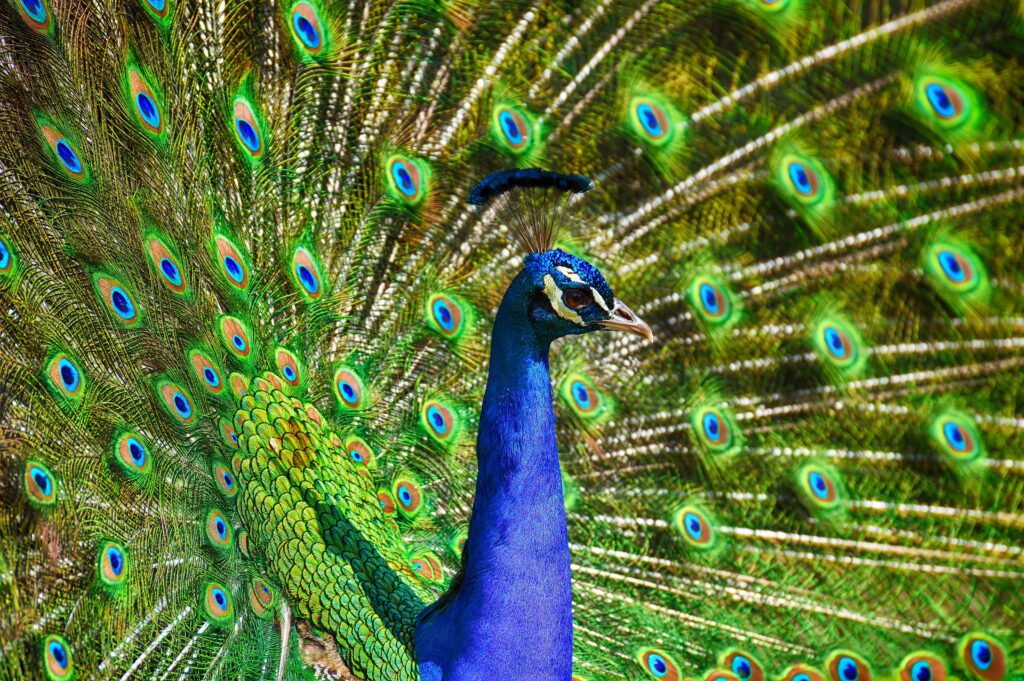
Peacock: The striking blue plumage of the peacock, with its iridescent feathers, adds to the allure of blue in nature. The peacock’s unique blue coloration is a stunning example of the rarity and beauty of blue in the animal kingdom.
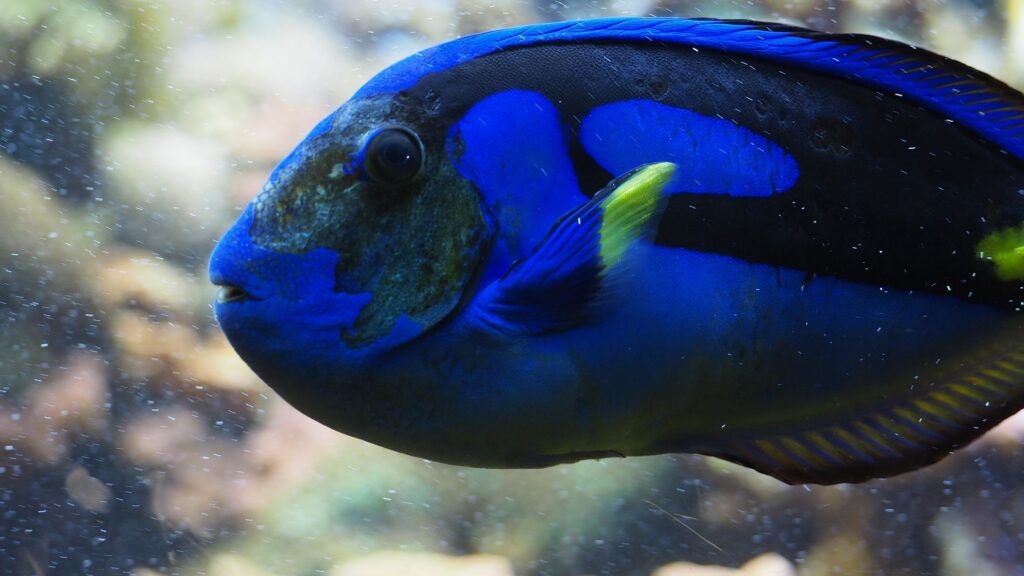
Blue tang fish: The blue tang fish, commonly found in coral reefs in the tropical waters of the Pacific and Indian Oceans, is known for its vibrant blue coloration.
These examples highlight the unique and diverse ways in which blue coloration can be found in nature, and how different molecules, structures, and elements contribute to the rarity of blue color in the natural world.
III. Historical Background
The rarity of blue color has an intriguing historical background that spans across ancient civilizations, medieval times, and the association of blue with wealth, power, and prestige throughout history.
A. 🔹 Ancient Civilizations’ Limited Access to Blue Pigments and Dyes 🎨
In ancient times, blue pigments and dyes were not readily available to civilizations, making the color blue a rarity. One of the reasons was the limited sources of natural blue pigments, which were challenging to obtain. For instance, in ancient Egypt, blue pigments were derived from minerals like azurite and lapis lazuli, which were rare and expensive. These pigments were used sparingly, mainly for decorative purposes in tombs and temples, and were not easily accessible to common people.
Similarly, in ancient Mesopotamia and Greece, blue pigments were scarce and mainly used for luxury items and high-ranking officials. The lack of availability of blue pigments in ancient civilizations made the color blue highly prized and reserved for the elite.
B. 🔹 Emergence of Blue Pigments in Medieval Times and Their High Cost 💰
During the medieval period, there was a gradual emergence of blue pigments, but they remained expensive and scarce. For example, the use of ultramarine blue, which was derived from grinding precious gemstone lapis lazuli into a pigment, became popular among European artists in the 13th century. However, due to its high cost, ultramarine blue was often reserved for important religious and commissioned artworks, and artists had to use it sparingly.
Another blue pigment that emerged during medieval times was smalt, which was made by grinding cobalt glass into a pigment. However, smalt was not as vibrant and durable as ultramarine blue, and its usage was limited to less prestigious works.
The high cost and limited availability of blue pigments during medieval times further added to the rarity of the color blue, making it a symbol of luxury and exclusivity.
C. 🔹 Blue’s Association with Wealth, Power, and Prestige Throughout History 💎
Blue has been historically associated with wealth, power, and prestige. Due to the rarity and cost of blue pigments, the color blue was often reserved for the nobility and the ruling class. In many cultures, blue was considered a status symbol, denoting wealth and social standing.
For instance, in medieval Europe, blue was often used in the robes and clothing of the Virgin Mary and other important religious figures, symbolizing their divine status and elevated position.
Blue’s association with wealth and power continued in later centuries as well. In the Renaissance era, blue pigments were used by famous artists like Leonardo da Vinci and Michelangelo to create masterpieces, showcasing the high status of their patrons.
Even today, blue is often associated with prestige and luxury. Many high-end brands use blue in their logos and packaging to convey a sense of exclusivity and elegance.
IV. Environmental Factors
The rarity of the color blue in nature is influenced by various environmental factors that play a significant role in creating blue hues. From scattering and refraction to interference and natural phenomena such as iridescence and the Tyndall effect, the complex interplay of these factors results in the beautiful blues we see in nature.
A. 🌞 Influence of environmental conditions on blue coloration 🌞
The coloration of blue in nature is often a result of the way light interacts with the environment. One of the primary factors that influence blue coloration is scattering, which occurs when light interacts with particles or molecules in the atmosphere or other mediums. When sunlight passes through the atmosphere, shorter wavelengths of light, such as blue and violet, are scattered more easily than longer wavelengths, leading to the iconic blue hues of the sky during the day.
B. Role of scattering, refraction, and interference in creating blue hues
Another environmental factor that affects blue coloration is refraction. Refraction occurs when light bends as it passes through mediums with different refractive indices. This bending of light can cause the separation of different wavelengths, resulting in the blue coloration we see in various natural phenomena, such as the blue color of water in oceans and lakes.
Interference is another crucial factor in creating blue hues. Interference occurs when light waves interact with each other, either constructively or destructively, leading to the amplification or cancellation of certain wavelengths. This phenomenon can result in the beautiful blues seen in the wings of butterflies and the feathers of birds, as well as in the vibrant blue coloration of some flowers and fruits.
C. 🌈 Examples of natural phenomena that result in blue coloration 🌈
Nature offers many stunning examples of blue coloration resulting from various phenomena. Iridescence, for instance, is a phenomenon where the color of an object changes depending on the viewing angle. This phenomenon is responsible for the dazzling blue hues seen in the wings of certain butterflies and the feathers of peacocks. Tiny scales on their wings or feathers diffract light, creating the mesmerizing iridescent blue colors that captivate our eyes.
The Tyndall effect is another fascinating natural phenomenon that contributes to blue coloration. The Tyndall effect occurs when light is scattered by particles suspended in a medium, such as air, water, or mist. This scattering of light causes shorter wavelengths, including blue, to scatter more easily, resulting in the blue coloration seen in the sky during twilight or in the misty spray of waterfalls.
D. 🚨 Impact of climate change and pollution on blue coloration in nature 🚨
Unfortunately, the beauty of blue coloration in nature is not immune to the effects of climate change and pollution. As climate change continues to alter weather patterns and environmental conditions, it can affect the scattering, refraction, and interference of light, potentially leading to changes in blue coloration in various natural phenomena.
Pollution, especially air pollution, can also impact blue coloration in nature. Fine particles and pollutants in the atmosphere can scatter and absorb light, leading to changes in the color of the sky and water bodies. For example, smog and haze caused by pollution can reduce the intensity of blue coloration in the sky, resulting in less vibrant and duller blues.
In addition, pollution in water bodies can also impact blue coloration. Pollutants can affect the transparency and composition of water, altering the way light interacts with it and changing the blue coloration of oceans, lakes, and rivers. This can have detrimental effects on aquatic ecosystems, disrupting the natural balance of blue coloration in underwater environments.
V. Cultural and Symbolic Significance of Blue 💙
The color blue has a rich cultural and symbolic significance in various societies, religions, and artistic expressions. Let’s delve into the captivating world of blue and explore its multifaceted meanings and effects.
A. Exploration of the Cultural Significance of Blue 💠
Blue holds a special place in different cultures around the world. In ancient Egypt, blue was associated with divinity and protection, and it was often used to adorn the tombs of pharaohs. In Hinduism, blue is associated with the god Shree Krishna, who is often depicted with blue skin, symbolizing his divine and transcendent nature. In Chinese culture, blue has been traditionally associated with immortality and wisdom, and it is often used in porcelain and ceramics to represent wealth and prestige.
In some Native American cultures, blue is associated with the sky and symbolizes spirituality and healing. In African cultures, blue is often associated with water, representing life, fertility, and purification. Blue is also a significant color in indigenous cultures in South and Central America, where it is often used in traditional textiles and pottery to represent the sky, water, and the cycle of life.
B. Symbolism of Blue in Art, Literature, and Folklore 🎨📚🧙♂️
Blue has been a source of inspiration for artists, writers, and storytellers throughout history. In art, blue has been used to represent a wide range of emotions and ideas. In Renaissance art, blue was often used to represent the divine and the celestial, and it was used to paint the robes of the Virgin Mary and other religious figures. In impressionist art, blue was used to convey a sense of tranquility and calmness, as seen in Claude Monet’s famous series of blue-hued water lily paintings.
In literature, blue has been used to convey a variety of meanings. In poetry, blue has been used to describe the vastness of the sea or the sky, symbolizing infinity and freedom. In folklore and mythology, blue has been associated with magic, mystery, and the supernatural. For example, in medieval European folklore, blue was associated with fairies and elves, and blue flowers were believed to have magical properties.
C. Psychological effects and emotions associated with the color blue 💭😢💙
Blue is known to have various psychological effects and can evoke different emotions depending on the context. In general, blue is often associated with feelings of calmness, tranquility, and serenity. It has a soothing effect on the mind and is often used in interior design and decor to create a peaceful atmosphere.
Blue is also associated with sadness and melancholy, as seen in phrases like “feeling blue” or “having the blues.” However, blue can also represent stability, trust, and reliability. Many corporate logos and uniforms use blue to convey a sense of professionalism and dependability.
ALSO READ: Imposter Syndrome – Self doubts and the Fear of Being Exposed!
VI. Evolutionary Significance
The color blue is often considered rare in nature, and its evolutionary significance can be attributed to several biological and ecological factors. From advantages and disadvantages of blue coloration to examples of animals that use blue coloration for survival, communication, and mating purposes, as well as coevolution between animals and their blue-colored environments, let’s explore the fascinating world of blue in nature.
A. Biological and Ecological Factors Driving the Evolution of Blue Coloration
- Pigment availability: One of the reasons why blue coloration is relatively rare in nature is that blue pigments are not as commonly available as other pigments. Unlike pigments such as melanin, which can produce a wide range of colors, including brown and black, blue pigments are chemically complex and require specific conditions for their production. This limited availability of blue pigments can drive the evolution of blue coloration in animals.
- Light scattering: The unique optical properties of blue coloration can also play a role in its evolutionary significance. Blue coloration in animals is often created through light scattering, where microscopic structures in the skin or feathers scatter light in a way that reflects the blue wavelength. This scattering effect can create vibrant and iridescent blue colors, which can be advantageous for survival, communication, or mating purposes.
B. Advantages and disadvantages of blue coloration in nature
- Camouflage: Blue coloration can provide advantages in terms of camouflage. In certain environments, such as open water or a clear blue sky, animals with blue coloration can blend in and avoid detection by predators or prey. For example, the blue poison dart frog, native to Central and South America, uses its bright blue coloration to stand out against the green foliage, warning predators of its toxic nature.
- Sexual selection: Blue coloration can also play a role in sexual selection, where animals use color as a signal to attract mates. In some species, males with brighter or more intense blue coloration may be seen as more attractive to females, leading to greater mating success. For example, the male peacock’s striking blue plumage is used in courtship displays to attract females during mating rituals.
- Warning coloration: Blue coloration can also serve as a warning signal to potential predators or competitors. For example, many species of venomous or poisonous animals, such as blue poison arrow frogs and blue poison arrow snails, use their blue coloration to signal their toxic or dangerous nature, deterring potential predators from attacking them.
C. Examples of Animals Using Blue Coloration for Survival, Communication, and Mating Purposes
- Blue Morpho butterfly: The Blue Morpho butterfly, found in Central and South America, is known for its stunning blue coloration. The blue coloration on the upper surface of its wings is created by microscopic scales that scatter light, giving the wings a brilliant blue appearance. This blue coloration not only helps the butterfly blend in with the sky when viewed from below, but it also serves as a warning signal to predators due to its brightness, deterring them from attacking.
- Blue poison dart frog: The blue poison dart frog, also known as the blue poison arrow frog, is a small, brightly colored frog native to Central and South America. Its bright blue coloration serves as a warning signal to predators, indicating its toxic nature. The blue coloration is believed to be an aposematic coloration, warning potential predators of the frog’s toxicity and deterring them from attacking.
- Blue peafowl: The male blue peafowl, also known as the peacock, is famous for its extravagant blue plumage, which it uses during courtship displays to attract females. The brilliant blue coloration of its feathers is believed to be an indicator of the male’s genetic fitness and overall health, making it an attractive trait for potential mates.
- Blue tang fish: The blue tang fish, commonly found in coral reefs in the tropical waters of the Pacific and Indian Oceans, is known for its vibrant blue coloration. The blue coloration not only helps it blend in with the colorful coral reef environment, but it is also believed to play a role in communication among members of its school. The blue tang fish uses its coloration to signal its presence, coordinate movements, and establish dominance hierarchies within the school.
D. Coevolution between animals and their blue-colored environments
- Coral reefs: Coral reefs, often referred to as the “rainforests of the sea,” are one of the most diverse ecosystems on Earth and are home to numerous species that exhibit blue coloration. Many of these species, such as the blue tang fish and the blue chromis damselfish, have evolved their blue coloration as an adaptation to blend in with the vibrant blue hues of the coral reef environment. This coevolution between the animals and their blue-colored environments allows them to effectively camouflage and thrive in their ecosystem.
- Sky and open water: Blue coloration can also be advantageous for animals that inhabit the open water or sky, such as birds and insects. For example, many seabirds, such as the blue-footed booby and the blue petrel, have evolved blue coloration in their feathers, which helps them blend in with the blue color of the ocean surface when viewed from above, making them less visible to potential predators. Similarly, some species of dragonflies and butterflies have developed blue coloration in their wings, which helps them blend in with the blue sky when viewed from below, providing them with a strategic advantage in evading predators.
VII. Human Impact
Blue is a captivating color that holds a unique appeal in nature. However, the rarity of blue coloration in the natural world has been influenced by human activities in various ways. Let’s explore how human intervention, environmental impacts, and conservation efforts have affected the presence of blue coloration in nature.
A. 🔬 Human Intervention in Creating Blue Coloration in Nature
Humans have been able to influence the occurrence of blue coloration in nature through selective breeding, genetic modification, and artificial means. For example, in agriculture, selective breeding has been used to create blue-colored fruits and flowers that are not commonly found in nature. Genetic modification techniques have also been employed to introduce blue color genes into organisms that do not naturally possess it, resulting in blue-colored animals or plants.
Similarly, artificial means such as dyeing and coloring have been used by humans to artificially create blue coloration in various materials, including textiles, ceramics, and artworks. These interventions have allowed humans to create blue coloration where it might not have been naturally present, but they have also had implications for the natural rarity of blue coloration.
B. 🌍 Environmental and Ecological Impacts of Human Activities on Blue Coloration Rarity
Human activities have had significant impacts on the rarity of blue coloration in nature through environmental and ecological changes. For instance, pollution, deforestation, and climate change have resulted in habitat destruction and alteration, leading to changes in the availability of blue-colored species’ natural habitats.
Pollution, including air pollution and water pollution, can also have detrimental effects on the quality of water bodies where blue-colored species reside. This can impact the survival and reproduction of these species, ultimately affecting the rarity of blue coloration in nature.
Furthermore, overfishing and destructive fishing practices, such as cyanide and dynamite fishing, can damage coral reefs, which are crucial habitats for many blue-colored marine species. Coral bleaching, caused by climate change, also poses a significant threat to the survival of blue-colored species that depend on healthy coral reefs.
C. 💚 Conservation Efforts to Protect Blue Coloration in Nature and its Importance in Biodiversity
Conservation efforts are critical in protecting the rarity of blue coloration in nature and maintaining biodiversity. Conservation organizations and scientists work tirelessly to understand the ecological importance of blue coloration and to implement measures to protect species that possess this unique coloration.
Efforts such as habitat restoration, pollution reduction, and sustainable fishing practices are important in conserving blue-colored species and their natural habitats. Conservation initiatives also focus on raising awareness among local communities, policymakers, and the general public about the importance of protecting blue coloration in nature and the need for sustainable practices to preserve biodiversity.
Blue coloration in nature is not just aesthetically appealing but also serves essential ecological functions, such as camouflage, communication, and mating strategies. It plays a crucial role in the balance and diversity of ecosystems, and efforts to protect blue-colored species contribute to the overall conservation of biodiversity.
VIII. Future Prospects 🌈
As we delve deeper into the world of science, technology, and research, the rarity of blue coloration in nature may be subject to change. Advances in various fields can potentially impact the prevalence of blue color in the natural world. Here are some exciting prospects for the future:
A. Advances in Technology and Research 🔬
With advancements in technology, scientists and researchers have the opportunity to unravel the mysteries behind blue coloration in nature. Cutting-edge tools such as spectrometry, chromatography, and genetic sequencing enable scientists to study the chemical composition of blue pigments and unravel the genetic mechanisms that govern blue coloration in organisms.
Research into the optical properties of materials and nanostructures has also opened up possibilities for creating synthetic materials that mimic the striking blue hues found in nature. For instance, researchers have developed artificial nanostructures that replicate the microscopic structures found in the wings of blue butterflies, which give them their vibrant blue color. These breakthroughs in technology and research may pave the way for new ways to produce blue coloration in materials, textiles, and even paints, reducing the reliance on rare and endangered species for obtaining blue pigments.
B. Potential for Biomimicry and Bioinspiration 🐾
Nature has always been a source of inspiration for human innovation. The rare and mesmerizing blue coloration found in organisms can inspire biomimicry and bioinspiration, which involve emulating nature’s design principles to solve human problems. For instance, researchers have looked to the blue morpho butterfly, known for its dazzling blue wings, to develop ultra-thin, light-reflecting coatings that can be used in a wide range of applications, including in optical devices and displays.
Furthermore, scientists have also studied the blue coloration in marine animals like blue whales and blue sharks to develop more efficient underwater communication systems for humans. By understanding the mechanisms behind the blue coloration in these organisms, researchers can develop technologies that can revolutionize our understanding of underwater communication and navigation.
C. Role of Education and Awareness 📚
Education and awareness play a crucial role in appreciating and preserving the rarity of blue coloration in nature. By fostering a sense of wonder and curiosity about the natural world, we can inspire the next generation of scientists, researchers, and innovators to explore the mysteries of blue coloration and work towards its preservation.
Educational initiatives that highlight the significance of blue coloration in nature, the threats it faces, and the need for conservation can raise awareness among the general public. This can include educational campaigns, museum exhibits, and outreach programs that highlight the beauty and ecological importance of blue coloration in organisms, and the need to protect endangered species that possess blue coloration.
In addition, promoting sustainable practices, such as responsible sourcing of blue pigments from renewable sources, reducing pollution and habitat destruction, and supporting conservation efforts, can contribute to the preservation of blue coloration in nature for future generations to admire and appreciate.
IX. Conclusion
As we wrap up our exploration of the rarity of blue coloration in nature, let’s recap the factors that contribute to this phenomenon. From the scientific perspective, the scarcity of blue color in the natural world can be attributed to various physical and chemical factors. One major factor is the physics of light scattering, where shorter wavelengths of light, such as blue, are scattered more easily than longer wavelengths, resulting in the blue color being absorbed or scattered before it reaches our eyes. Additionally, the chemical composition of organisms and their evolutionary adaptations play a role in the rarity of blue coloration. For example, blue pigments are often complex and difficult to produce, making them less common in nature.
However, beyond the scientific explanations, there is an undeniable beauty and significance to the presence of blue in the natural world. Blue is a color that has captivated human beings for centuries, evoking feelings of tranquility, serenity, and wonder. From the clear blue skies to the shimmering blue waters, blue is a color that is associated with vastness, depth, and infinity. In nature, blue can be found in various forms, from the delicate petals of blue flowers to the iridescent wings of blue butterflies, from the striking plumage of bluebirds to the majestic hues of blue whales. The rarity of blue coloration in nature makes it all the more precious and awe-inspiring.
As we gain a deeper understanding of the factors that contribute to the rarity of blue color in nature and appreciate the beauty and significance of blue in the natural world, it is crucial to recognize the importance of conservation and preservation efforts to protect and sustain this precious coloration. Human activities such as pollution, habitat destruction, and climate change can have detrimental effects on the delicate ecosystems where blue coloration exists. It is our responsibility to take action to protect and conserve these habitats to ensure that future generations can continue to appreciate the magnificence of blue in nature.
🌍🌿🌊🐋🌼🦋🐦🔵
In conclusion, the rarity of blue coloration in nature is a captivating phenomenon that encompasses scientific, aesthetic, and environmental aspects. Understanding the scientific factors behind this rarity, appreciating the beauty and significance of blue in the natural world, and taking action to conserve and preserve blue coloration in nature are essential steps towards safeguarding this precious gift of nature. Let us cherish the magic of blue in nature and work together to ensure its preservation for generations to come. 💙🌈🌍
Also Read: Why Blue is so Rare? By TED Ed

I am not sure where youre getting your info but good topic I needs to spend some time learning much more or understanding more Thanks for magnificent info I was looking for this information for my mission